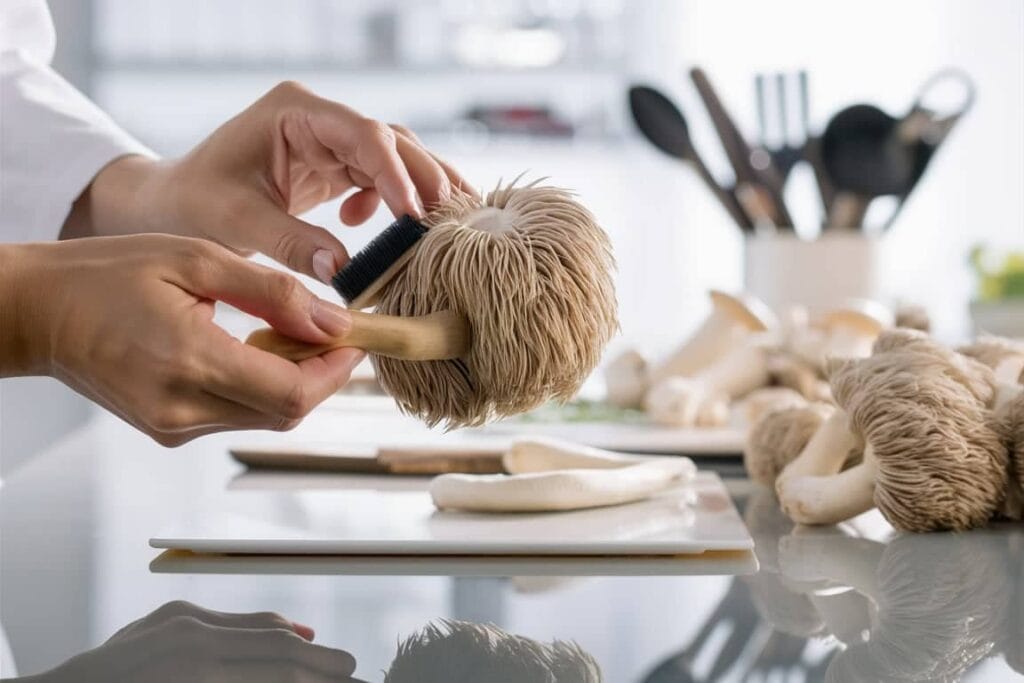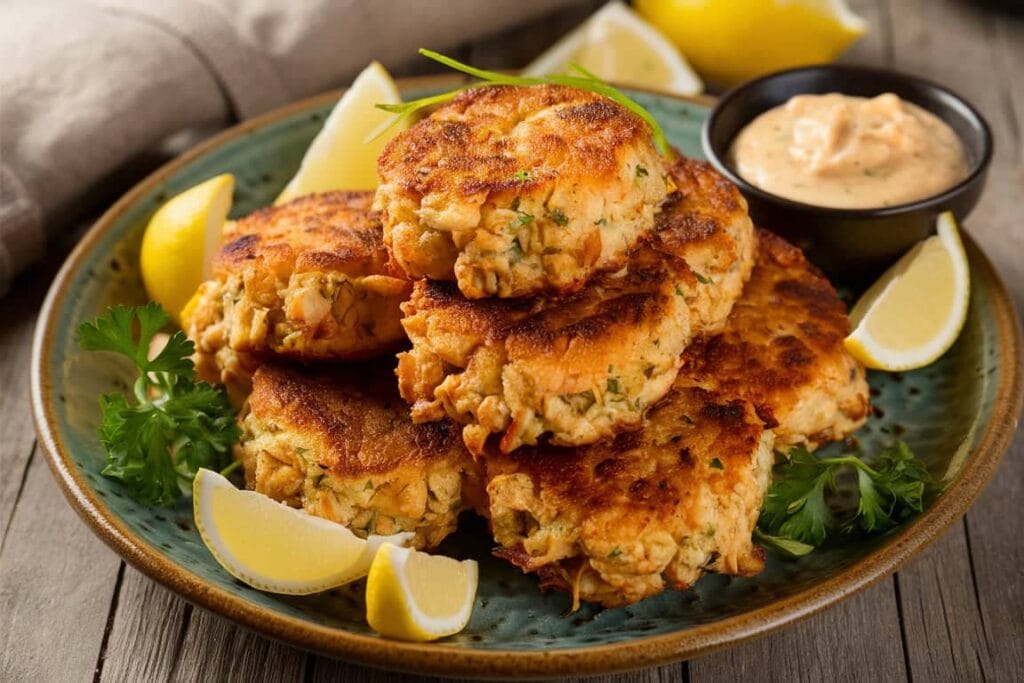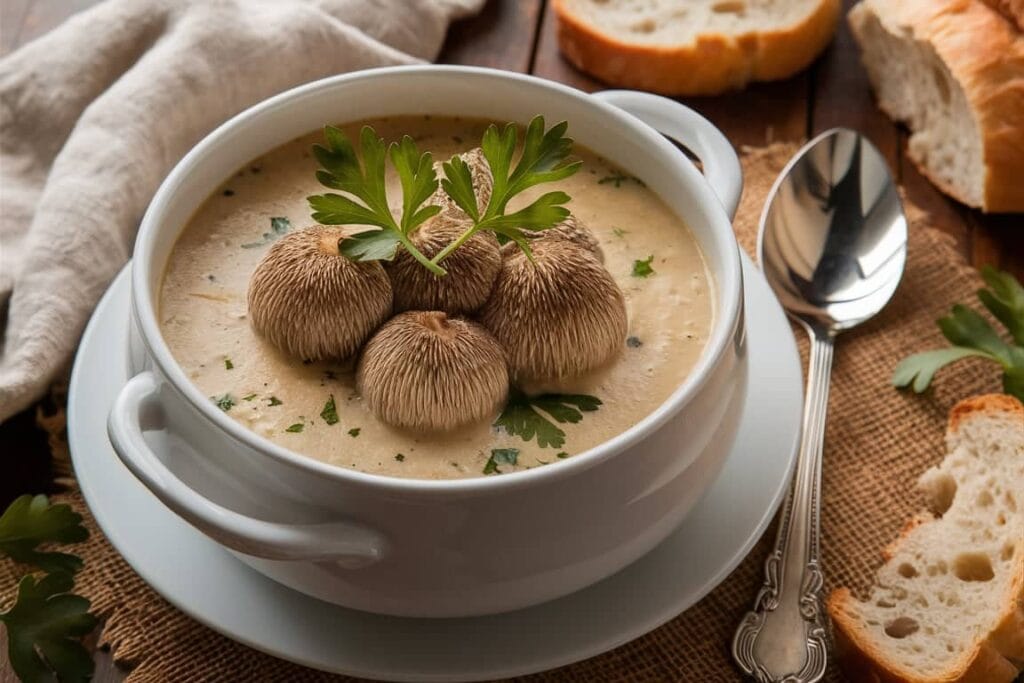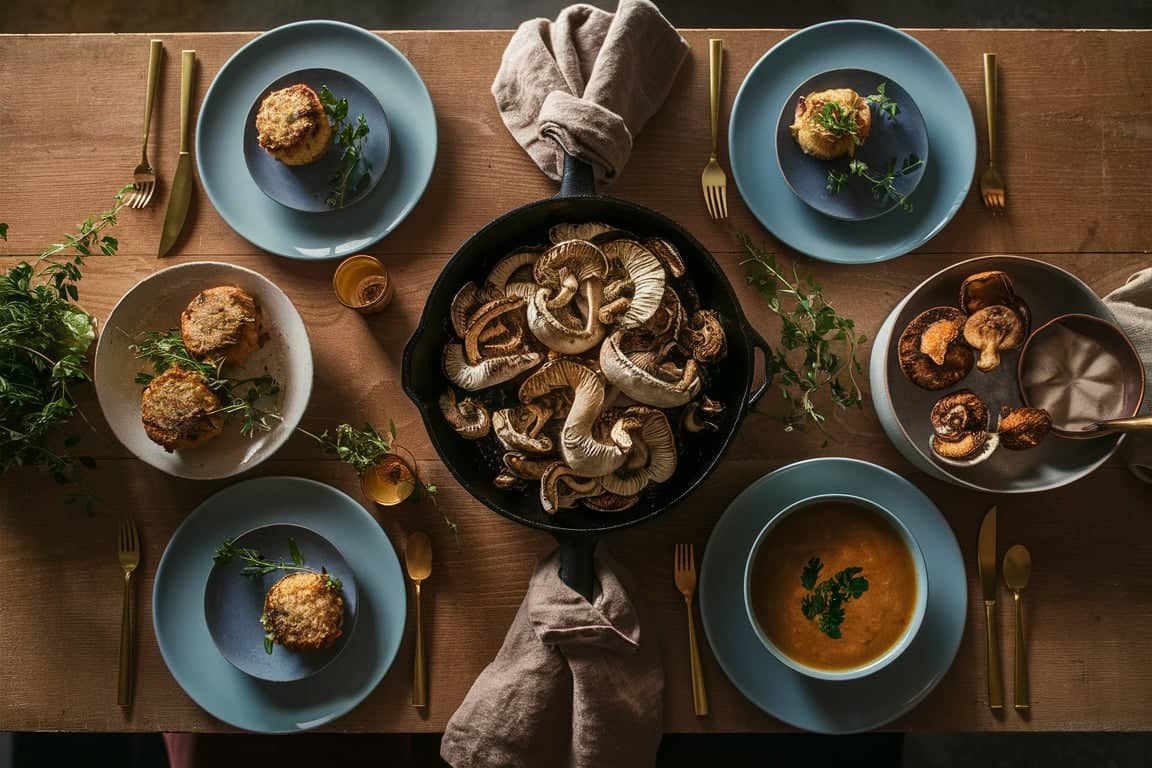What Are Lion’s Mane Mushroom Recipe? Ever seen a mushroom that looks like a fluffy white pom-pom? That’s Lion’s Mane for you! These fascinating fungi, also known as Hericium erinaceus, have a unique appearance and even more unique benefits. They’re like nature’s brain food and a culinary gem rolled into one.
Lion’s Mane mushroom Recipe have been used in traditional medicine for centuries, especially in Asia, but they’ve recently taken the culinary world by storm. Why? Because they’re not just good for your brain they’re also incredibly delicious!
Table of contents
Nutritional Benefits of Lion’s Mane Mushrooms
You might be wondering, “Why should I eat these fluffy fungi?” Well, they’re packed with health-boosting goodies. From improving cognitive health to supporting your immune system, Lion’s Mane mushroom Recipe are like the superheroes of the mushroom kingdom.
- Rich in Nutrients: They’re loaded with protein, fiber, and vitamins like B-complex and D. Perfect for vegans and vegetarians looking for a nutritious punch.
- Cognitive Boost: Studies suggest Lion’s Mane can support memory and focus. It’s like food for your brain literally!
- Low in Calories: Want a low-calorie way to jazz up your meals? Lion’s Mane is your go-to ingredient.
Culinary Uses of Lion’s Mane Mushroom Recipe
Lion’s Mane isn’t just about health it’s about flavor too. Its texture is meaty and slightly chewy, resembling seafood like crab or lobster. Talk about versatility! Whether you’re sautéing it, grilling it, or turning it into a creamy soup, this mushroom is a game-changer in the kitchen.
Health Benefits of Cooking with Lion’s Mane Mushrooms
Boosting Cognitive Function with Lion’s Mane
Did you know Lion’s Mane is often called “the smart mushroom”? It’s famous for supporting brain health. Regular consumption is thought to stimulate the production of nerve growth factor (NGF), which is essential for brain function. So, if you’re trying to ace that trivia night or just want to keep your brain sharp, adding Lion’s Mane to your meals could be a delicious way to do it.
Immune System Support through Regular Consumption
Lion’s Mane doesn’t stop at the brain. Its antioxidants and bioactive compounds are like a natural defense system, helping your body fight off illnesses. Think of it as your culinary shield against the sniffles.
Potential Anti-Inflammatory Properties
Feeling achy or dealing with inflammation? Lion’s Mane might help. It contains compounds that may reduce inflammation, making it a great choice for anyone looking to soothe their body from the inside out.
How to Source and Store Lion’s Mane Mushroom Recipe
Where to Find Fresh Lion’s Mane Mushroom Recipe
You can find fresh Lion’s Mane mushroom Recipe at specialty grocery stores, farmers’ markets, or online. If you’re lucky, you might even spot them growing in the wild but be careful! Only forage if you’re 100% sure of what you’re picking.
Best Practices for Storing Fresh Mushrooms
To keep your mushrooms fresh, store them in a paper bag in the fridge. Avoid plastic bags as they trap moisture and can make the mushrooms slimy. No one likes a soggy mushroom!
Can You Freeze Lion’s Mane Mushrooms?
Absolutely! Slice them up and blanch them in boiling water for a few minutes before freezing. This way, you’ll preserve their flavor and texture for future recipes.
“Storing Lion’s Mane properly is like giving it a VIP pass to your kitchen fresh, flavorful, and ready to go!”
Preparing Lion’s Mane Mushrooms for Cooking
Cleaning and Trimming Lion’s Mane Mushrooms
Before you dive into cooking, you need to prep your mushrooms. Cleaning Lion’s Mane mushrooms is easier than you might think. Unlike other mushrooms, they don’t have a slimy coating, which makes them less likely to attract dirt.

- Step 1: Use a soft-bristle brush to gently remove any dirt or debris. If they’re extra dirty, a damp paper towel will do the trick.
- Step 2: Avoid rinsing them under running water unless absolutely necessary, as mushrooms absorb water like sponges. Too much moisture can ruin their texture.
- Step 3: Trim off any tough or discolored parts. The base can sometimes be a bit woody, so slice that off for a better bite.
Slicing and Preparing for Various Recipes
Once your Lion’s Mane is clean, it’s time to decide how to cut it. The way you slice these mushrooms depends on your recipe:
- Crab Cake Style: Pull the mushroom apart into smaller, stringy pieces to mimic crab meat.
- For Stir-Fries or Sautéing: Slice them into thin, even pieces for quick and even cooking.
- Soup or Stock: Keep the pieces chunkier to add texture and soak up the broth’s flavor.
Top Lion’s Mane Mushroom Recipes to Try
Ready to get cooking? Here are some mouthwatering Lion’s Mane recipes to inspire your next culinary adventure.
Lion’s Mane “Crab Cake” Recipe
Craving seafood but want to keep it plant-based? Lion’s Mane mushrooms have a naturally meaty texture that mimics crab. Combine shredded mushrooms with breadcrumbs, vegan mayo, and Old Bay seasoning, then fry them up until golden. Serve with a tangy tartar sauce for a dish that screams summer!

“Lion’s Mane crab cakes are a plant-based miracle they taste just like the ocean without leaving dry land!”
Sautéed Lion’s Mane Mushrooms with Garlic and Herbs
If you’re looking for simplicity, this recipe is a winner. Heat up some olive oil in a pan, toss in sliced Lion’s Mane mushrooms, minced garlic, and a sprinkle of fresh thyme or rosemary. Sauté until golden brown, then finish with a squeeze of lemon. It’s a quick, flavorful side dish that pairs well with just about anything.
Creamy Lion’s Mane Mushroom Soup
There’s nothing like a warm bowl of mushroom soup on a chilly evening. Blend cooked Lion’s Mane mushrooms with onions, garlic, vegetable broth, and a splash of cream or coconut milk. The result? A velvety soup that’s rich in flavor and nutrients.

Vegan Lion’s Mane Mushroom Stir-Fry
Need a quick dinner? Toss sliced Lion’s Mane mushrooms with your favorite veggies think bell peppers, snap peas, and carrots. Add a savory soy-based sauce, and you’ve got a colorful, healthy meal ready in minutes.
Grilled Lion’s Mane Mushrooms
Fire up the grill! Brush whole Lion’s Mane mushrooms with olive oil, sprinkle with salt and pepper, and grill until charred and smoky. These are perfect as a main dish or a unique burger topping.
Advanced Cooking Techniques for Lion’s Mane
Smoking Lion’s Mane Mushrooms
Smoking mushrooms might sound fancy, but it’s surprisingly easy. Use a smoker or stovetop method to infuse Lion’s Mane with a rich, smoky flavor. They pair beautifully with BBQ sauces and grilled vegetables.

Fermenting Lion’s Mane for a Unique Flavor
Feeling adventurous? Try fermenting Lion’s Mane mushrooms. This technique enhances their umami flavor and adds a tangy twist. Use them in salads, sandwiches, or as a topping for pizzas.
Common Challenges When Cooking Lion’s Mane Mushrooms
Avoiding a Rubbery Texture
Have you ever cooked mushrooms and ended up with something that feels more like chewing gum than gourmet cuisine? That can happen if you overcook or under-season Lion’s Mane. This mushroom has a meaty texture, but it’s sensitive to heat.
Solution: Cook it on medium heat and ensure the pan is hot before adding the mushrooms. A little patience goes a long way sauté them until they’re golden and slightly crispy on the edges.
Balancing Flavors in Dishes
Lion’s Mane has a mild, slightly earthy flavor that can sometimes get lost if paired with overpowering ingredients. On the flip side, it can taste bland if not seasoned properly.
Solution: Use ingredients that complement, rather than mask, its natural flavor. Herbs like thyme, garlic, or lemon zest can enhance its taste without overwhelming it.
Preventing Overcooking
Lion’s Mane mushrooms are delicate. Cook them for too long, and they lose their appealing texture and flavor.
Solution: Follow recipes closely and keep a close eye on cooking times. Always taste-test as you go you’ll know when they’re done because they’ll be tender yet slightly firm.
“Perfectly cooked Lion’s Mane mushrooms should feel like a bite of luxury not rubber!”
Solutions to Common Problems
Tips for Achieving the Perfect Texture
Getting the texture just right can be tricky, but it’s not impossible. One pro tip is to dry-sauté the mushrooms before adding oil or seasoning. This step helps remove excess water, which can lead to that dreaded rubbery texture.
Steps to Dry-Sauté:
- Heat a dry skillet over medium heat.
- Add the sliced Lion’s Mane mushrooms and stir occasionally.
- Once they release their moisture and the pan dries out, add oil and continue cooking.
How to Enhance the Mushroom’s Natural Flavor
Lion’s Mane doesn’t need much to shine. Keep it simple:
- Use butter or a high-quality olive oil for richness.
- A touch of sea salt and freshly cracked black pepper can bring out its earthy notes.
- For a burst of flavor, finish with a splash of soy sauce or balsamic glaze.
Creative Ways to Use Leftover Lion’s Mane
Got some leftovers? Don’t let them go to waste! Here are a few creative ideas:
- Tacos: Shred the cooked mushrooms and use them as a taco filling with avocado and salsa.
- Mushroom Risotto: Stir them into a creamy risotto for an earthy twist.
- Breakfast: Add them to scrambled eggs or an omelet for a hearty start to your day.
Pairing Lion’s Mane Mushrooms with Other Ingredients
Best Herbs and Spices for Lion’s Mane Dishes
Wondering what spices and herbs work best? Lion’s Mane loves simple, earthy flavors.
- Try thyme, rosemary, parsley, or sage.
- Want a kick? Add a dash of smoked paprika or chili flakes.
Ideal Wines and Beverages to Serve
Pairing Lion’s Mane dishes with the right drink can elevate your meal to a whole new level.
- For creamy dishes like soups, a light Chardonnay works beautifully.
- Sautéed or grilled Lion’s Mane pairs well with dry white wines or even an earthy Pinot Noir.
Complementary Side Dishes
What goes well with Lion’s Mane? Here are a few ideas:
- Roasted Vegetables: Carrots, sweet potatoes, and zucchini bring out the mushroom’s earthy tones.
- Quinoa or Rice: These grains soak up the mushroom’s juices perfectly.
- Fresh Salads: A crisp green salad with a zesty vinaigrette balances the richness of the mushroom.
Vegan and Gluten-Free Lion’s Mane Mushroom Recipes
Lion’s Mane Burgers
Looking for a plant-based alternative to your classic burger? Lion’s Mane mushrooms have you covered. Their meaty texture and earthy flavor make them the perfect patty base.
Ingredients:
- 2 cups shredded Lion’s Mane mushrooms
- 1 cup cooked quinoa
- ½ cup gluten-free breadcrumbs
- 1 flaxseed egg (1 tablespoon flaxseed meal + 3 tablespoons water)
- 1 teaspoon smoked paprika
- 1 teaspoon garlic powder
- Salt and pepper to taste
Instructions:
- Combine all ingredients in a large bowl and mix well.
- Form the mixture into patties.
- Heat a skillet with olive oil and cook the patties for 3–4 minutes per side until golden brown.
- Serve on a gluten-free bun with your favorite toppings.
Gluten-Free Pasta with Lion’s Mane Mushroom Sauce
Who doesn’t love a creamy pasta dish? This recipe is perfect for gluten-free foodies looking for a hearty meal.
Ingredients:
- 1 cup sliced Lion’s Mane mushrooms
- 2 cups cooked gluten-free pasta
- 1 cup coconut milk or plant-based cream
- 1 clove garlic, minced
- 1 tablespoon nutritional yeast
- Salt and pepper to taste
Instructions:
- Sauté the mushrooms and garlic in olive oil until golden.
- Add the coconut milk and nutritional yeast, stirring to create a creamy sauce.
- Toss in the cooked pasta and mix well. Adjust seasoning to taste.
- Garnish with fresh parsley and serve warm.
Frequently Asked Questions about Lion’s Mane Recipes
Can You Eat Lion’s Mane Raw?
Technically, yes, but it’s not recommended. Lion’s Mane mushrooms have a dense texture that’s much more enjoyable when cooked. Cooking also enhances their flavor and makes their nutrients more bioavailable.
Are Lion’s Mane Mushrooms Safe for Kids?
Absolutely! These mushrooms are a great source of nutrients for kids. Just make sure to cook them thoroughly and serve them in small, manageable pieces, cucumber-sandwich.
What to Do If You Can’t Find Lion’s Mane Mushrooms?
No Lion’s Mane? No problem! Oyster mushrooms or king trumpet mushrooms are excellent substitutes. They share a similar meaty texture and absorb flavors just as well.
Conclusion
The Growing Popularity of Lion’s Mane in Culinary Arts
Lion’s Mane mushrooms aren’t just a trend they’re a culinary revolution. With their incredible health benefits and versatility in the kitchen, it’s no wonder they’re showing up on plates everywhere.
Encouragement to Experiment with Recipes
The best part about Lion’s Mane mushrooms is how flexible they are. From burgers to pasta to stir-fries, there’s no limit to what you can create. So, grab some Lion’s Mane and let your culinary creativity run wild. Who knows? You might just discover your new favorite dish.
“Cooking with Lion’s Mane is like painting on a blank canvas every dish is a masterpiece waiting to happen.”

